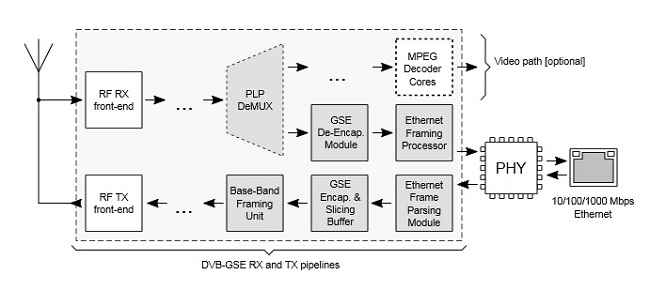DVB-GSE Ethernet Tunnel IP Cores
Overview
High-throughput, low-latency Ethernet frame parsers & generators, and DVB-GSE encapsulator & de-encapsulator IP cores, for building datalink systems that transport Ethernet frames using DVB-GSE. The IP Core Worx DVB-GSE IP cores have been optimised for high performance, and also for DVB-S2/-T2/ C2 implementations that have strict resource/area constraints; for example, FPGA-based systems.
Pairing the IP Core Worx DVB-GSE Ethernet tunnel encapsulator core with its corresponding de-encapsulator core minimises the footprint & complexity of a bidirectional DVB-GSE system. (De-)Encapsulating of just layer 2 (Ethernet) traffic shifts the tasks of routing & QoS to external cores or devices (at each end of the Ethernet tunnel), increasing system flexibility and reducing FPGA resource requirements.
Features
DVB-GSE encapsulator and de-encapsulator IP cores with AXI4-Stream interconnect to/from (RG)MII interfaces.

- GSE encapsulation of Ethernet frames (via the DVB-GSE Bridged Frame Mandatory Extension Header)
- Designed for high throughput and low latency
- Configurable MTU’s, SRAM/buffer sizes, and packing & fragmentation modes
- Supports GSE packet header types for no labels, 6 byte labels, label reuse, and label-based filtering
- Low (logic and SRAM) resource usage
- Support for both 16200b and 64800b BBFRAME’s, and all DATA FIELD sizes
- AXI4-Stream Interconnect (to/from PHY’s and FEC units)
- Wishbone (SPEC B4) interface for control and packet/device statistics
- CRC-8 for BBFRAME’s, and CRC-32 for reassembled PDU’s and Ethernet frames
- Robust exception handling and with rapid recovery from exceptions (due to overflows & invalid input data)
- Can be configured for single- or dual- clock operation
Deliverables
- Netlist or synthesisable RTL source code in VHDL
- Comprehensive verification test bench and vectors in VHDL
- User guides and documentation for integration & configuration
- Top-level entities for CCM-only, Ethernet-tunneling systems to aid with evaluation and rapid-prototyping
Performance
The following table shows the resource utilisation for various IP Core Worx DVB-GSE cores, when using Xilinx Vivado for synthesis, and targeting Xilinx ZYNQ devices. The designs satisfy the timing constraints at more than 160 MHz (ZYNC devices) – exceeding GbE performance with FPGA-based designs.
| Resource | IP_TO_GSE | GSE_TO_IP | ETH_TO_GSE | GSE_TO_ETH |
| LUT6 | 720 | 303 | 1086 | 638 |
| DFF | 411 | 228 | 655 | 455 |
| RAM36 | 0.5 | 0.5 | 2 | 1.5 |
| DSP | 0 | 0 | 0 | 0 |
| BUFG | 1 | 1 | 1 | 1 |
